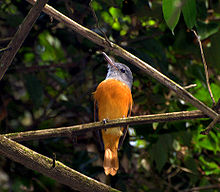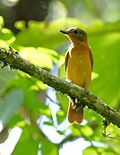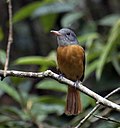Attila (bird)
| Attila | |
|---|---|

| |
| Grey-hooded attila | |
| Scientific classification | |
| Domain: | Eukaryota |
| Kingdom: | Animalia |
| Phylum: | Chordata |
| Class: | Aves |
| Order: | Passeriformes |
| Family: | Tyrannidae |
| Genus: | Attila Lesson, RP, 1831 |
| Type species | |
| Attila brasiliensis[1] = Muscicapa spadicea Lesson, 1831 | |
| Synonyms | |
|
Dasycephala | |
Attila is a genus of tropical passerine birds, the attilas. They belong to the tyrant flycatcher family. The species in this genus have large heads and hooked bills; they are markedly predatory and aggressive for their size – hence the scientific and common names, which refer to Attila the Hun.
Taxonomy
The genus Attila was introduced in 1831 by the French naturalist René Lesson to accommodate a single species, the bright-rumped attila, which is therefore considered as the type species.[2][3] The genus name is from Attila the Hun who attacked Rome and Orléans in the 5th century.[4][5]
The genus contains seven species:[6]
| Image | Scientific name | Common Name | Distribution |
|---|---|---|---|
 |
Attila phoenicurus | Rufous-tailed attila | southern Paraguay and Brazil; also extreme northeast Argentina, Bolivia and southern Venezuela |
 |
Attila cinnamomeus | Cinnamon attila | Brazil, Colombia, Venezuela, Guyana, Suriname, and French Guiana; also Amazonian Ecuador, Peru, and regions of Bolivia. |
 |
Attila torridus | Ochraceous attila | Colombia, Ecuador, and Peru |
 |
Attila citriniventris | Citron-bellied attila | Brazil, Colombia, Ecuador, Peru, and Venezuela. |
 |
Attila bolivianus | White-eyed attila | Bolivia, Brazil, Colombia, Peru, and possibly Ecuador. |
 |
Attila rufus | Grey-hooded attila | Brazil. |
 |
Attila spadiceus | Bright-rumped attila | northwestern Mexico to western Ecuador, Bolivia and southeastern Brazil, and on Trinidad |
References
- ^ "Tyrannidae". aviansystematics.org. The Trust for Avian Systematics. Retrieved 2023-07-16.
- ^ Lesson, René (1831). Traité d'Ornithologie, ou Tableau Méthodique (in French). Vol. 1. Paris: F.G. Levrault. p. 360 (livr. 5). Published in 8 livraisons between 1830 and 1831. For the publication date see: Dickinson, E.C.; Overstreet, L.K.; Dowsett, R.J.; Bruce, M.D. (2011). Priority! The Dating of Scientific Names in Ornithology: a Directory to the literature and its reviewers. Northampton, UK: Aves Press. p. 119. ISBN 978-0-9568611-1-5.
- ^ Traylor, Melvin A. Jr, ed. (1979). Check-List of Birds of the World. Vol. 8. Cambridge, Massachusetts: Museum of Comparative Zoology. p. 186.
- ^ Jobling, James A. (2010). The Helm Dictionary of Scientific Bird Names. London: Christopher Helm. p. 60. ISBN 978-1-4081-2501-4.
- ^ Susan Myers (25 October 2022). The Bird Name Book : A History of English Bird Names. Princeton University Press. ISBN 978-0-691-23685-8.
- ^ Gill, Frank; Donsker, David; Rasmussen, Pamela, eds. (January 2023). "Tyrant flycatchers". IOC World Bird List Version 13.1. International Ornithologists' Union. Retrieved 21 March 2023.
Further reading
- Hilty, Steven L. (2003): Birds of Venezuela. Christopher Helm, London. ISBN 0-7136-6418-5
- Stiles, F. Gary & Skutch, Alexander Frank (1989): A guide to the birds of Costa Rica. Comistock, Ithaca. ISBN 0-8014-9600-4

